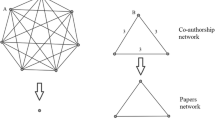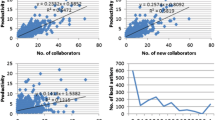Abstract
Even though social networking sites are very popular all around the globe, social networks for professionals have not received much attention from the scientific community. We study how physicians interact with each other from the perspective of network analysis. In our study, we treat each physician as a node, and the link between them represents their interaction through posting and comments. We study the topological features of the network of physicians. Structural statistics, such as power-law degree distribution, reciprocity, assortativity, and bow-tie structure are discussed. Moreover, physicians’ demographic information is included in our analysis to uncover features of the network. We discover the community structure of the network on the basis of physicians’ specialties. Inter- and intra-specialty communications are examined. Our study contributes to the literature a study on a medium-scale professional social network. The systematic analysis presents a full picture of the network with more detailed and in-depth understanding.














Similar content being viewed by others
References
Ahn Y, Han S, Kwak H, Moon S, Jeong H (2007) Analysis of topological characteristics of huge online social networking services. Paper presented at the World Wide Web, Banff
Albert R, Jeong H, Barabasi A-L (1999) Internet: diameter of the World-Wide Web. Nature 401(6749):130–131
Amaral LAN, Scala A, Barthelemy M, Stanley HE (2000) Classes of small-world networks. PNAS 97(21):11149–11152
Baldi P, Frasconi P, Smyth P (2003) Modeling the internet and the web: probabilistic methods and algorithms. Wiley, Chichester
Borgatti SP, Cross R (2003) A relational view of information seeking and learning in social networks. Manage Sci 49(4):432–445
Broder A, Kumar R, Maghoul F, Raghavan P, Rajagopalan S, Stata R, Tomkins A (2000) Graph structure in the web. Comp Netw Intern J Comp Telecommun Netw 33(1–6):309–320
Clauset A, Shalizi CR, Newman MEJ (2009) Power-law distributions in empirical data. SIAM Rev 51(4):661–703
de Nooy W, Mrvar A, Batagelj V (2005) Exploratory social network analysis with Pajek. Cambridge University Press, Cambridge
de Souza CS, Preece J (2004) A framework for analyzing and understanding online communities. Interact Comput 16(3):579–610
Fu F, Liu L, Wang L (2008) Empirical analysis of online social networks in the age of Web 2.0. Physica A: Statist Mech Appl 387(2–3):675–684
Han S, Kim BJ (2008) Network analysis of an online community. Physica A: Statist Mech Appl 387(23):5946–5951
Hansen D, Shneiderman B, Smith M (2010) Analyzing social media networks with NodeXL. Morgan Kaufmann
Jackson MO (2008) Social and economic networks. Princeton University Press, Princeton
Java A, Song X, Finin T, Belle T (2007) Why we Twitter: understanding microblogging usage and communities. Paper presented at the Proceedings of the 9th WebKDD and 1st SNA-KDD 2007 workshop on Web mining and social network analysis, San Jose
Kleinberg JM (1999) Hubs, authorities, and communities. ACM Comput Surv 31(4)
Kleinberg JM (2001) Small-world phenomena and the dynamics of information, vol 14. Advances in Neural Information Processing Systems (NIPS)
Lehmann EL, D’Abrera HJM (1998) Nonparametrics: statistical methods based on ranks. Prentice-Hall, Englewood Cliffs
Lewis K, Kaufman J, Gonzalez M, Wimmer A, Christakis N (2008) Tastes, ties, and time: a new social network dataset using Facebook.com. Soc Netw 30(4):330–342
McLure Wasko M, Faraj S (2005) Why should I share? Examining social capital and knowledge contribution in electronic networks of practice. MIS Q 29(1):35–57
Milgram S (1967) The small world problem. Psychol Today 2:60–67
Mislove A, Marcon M, Gummadi KP, Druschel P, Bhattacharjee B (2007) Measurement and Analysis of Online Social Networks. Paper presented at the 7th ACM SIGCOMM conference on Internet measurement, San Diego
Newman MEJ (2003a) Mixing patterns in networks. Phys Rev E 67(2):026126
Newman MEJ (2003b) The structure and function of complex networks. SIAM Rev 45:167–256
Newman MEJ (2004) Coauthorship networks and patterns of scientific collaboration. PNAS 101:5200–5205
Porter J (2008) Designing for the social web. New Riders Press, Berkeley
Rosen D, Suthers D (2011) Stigmergy and collaboration: tracing the contingencies of mediated interaction. In: Proceedings of the 44th Hawaii International Conference on System Sciences
Rosen D, Barnett GA, Kim JH (2010) Social networks and online environments: when science and practice co-evolve. Soc Netw Analysis Min 1(1):27–42
Shi X, Tseng B, Adamic LA (2007) Looking at the blogosphere topology through different lenses. Paper presented at the ICWSM, Colorado
Turner TC, Smith MA, Fisher D, Welser HT (2005) Picturing usenet: mapping computer-mediated collective action. J Comp-Mediat Commun 10(4)
Wasserman S, Faust K (1994) Social Network Analysis: Methods and Applications. Cambridge University Press, New York
Watts DJ (1999) Networks, dynamics, and the small-world phenomenon. Am J Sociol 105(2):493–527
Watts DJ, Strogatz SH (1998) Collective dynamics of ‘small-world’ networks. Nature 393:440–442
Xu J, Chen H (2008) The topology of dark networks. Commun ACM 51(10):58–65
Zhang J, Ackerman MS, Adamic L (2007) Expertise networks in online communities: structure and algorithms. Paper presented at the World Wide Web, Banff
Author information
Authors and Affiliations
Corresponding author
Rights and permissions
About this article
Cite this article
Hua, G., Haughton, D. A network analysis of an online expertise sharing community. Soc. Netw. Anal. Min. 2, 291–303 (2012). https://doi.org/10.1007/s13278-012-0047-y
Received:
Revised:
Accepted:
Published:
Issue Date:
DOI: https://doi.org/10.1007/s13278-012-0047-y




